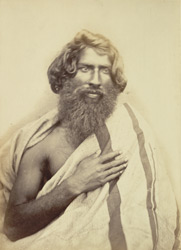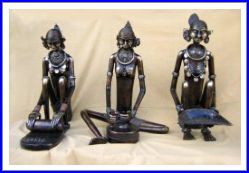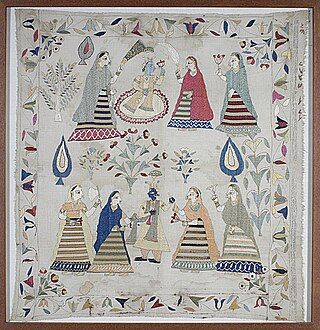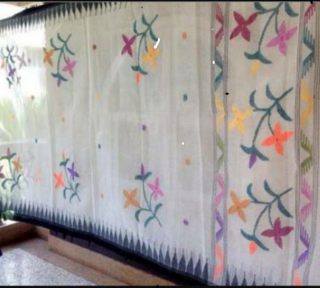
Papier-mâché, frequently miswritten as paper mache, is a composite material consisting of paper pieces or pulp, sometimes reinforced with textiles, and bound with an adhesive, such as glue, starch, or wallpaper paste.

Jamawar, or gown piece, is a special type of shawl made in Kashmir, India. "Jama" means robe and "war/var" is yard. The best quality of Jamawar is built with Pashmina. The brocaded parts are woven in similar threads of silk or polyester. Most of the designs seen today are floral, with the kairy as the predominant motif. Historically handmade items, some shawls took a couple of decades to complete; consequently, original Jamawar shawls are highly valued. Modern, machine-made Jamawar prints, produced in cities such as Kashmir and other parts of Himachal Pradesh cost less to buy but handmade Jamawar are very expensive.
The Office of the Controller General of Patents, Designs and Trade Marks(CGPDTM) generally known as the Indian Patent Office, is an agency under the Department for Promotion of Industry and Internal Trade which administers the Indian law of Patents, Designs and Trade Marks.

Bhimber is a town and the headquarters of the eponymous district in Pakistan-administered Azad Kashmir. The town and district are between the Jammu region of Indian-administered Kashmir and Pakistan proper, about 47 km (29 mi) by road southeast of Mirpur.

Kashmiri papier-mâché is a handicraft of Kashmir that was brought by Muslim saint Mir Sayyid Ali Hamadani from Persia in the 14th century to medieval India. It is based primarily on paper pulp, and is a richly decorated, colourful artifact; generally in the form of vases, bowls, or cups, boxes, trays, bases of lamps, and many other small objects. These are made in homes, and workshops, in Srinagar, and other parts of the Kashmir Valley, and are marketed primarily within India, although there is a significant international market. The product is protected under the Geographic Indication Act 1999 of Government of India, and was registered by the Controller General of Patents Designs and Trademarks during the period from April 2011 to March 2012 under the title "Kashmir Paper Machie".

The Thanjavur Art Plate is an artifact which is exclusively made in Thanjavur, Tamil Nadu, India. It is a circular plate made as a gift item. It is a handicraft consisting of metals such as silver, bronze, and copper embossed with figures of gods and goddesses at its center. The artwork has been registered for protection under the Geographical indication of the Trade Related Intellectual Property Rights (TRIPS) agreement. It is listed at item 63 as "Thanjavur Art Plate" of the GI Act 1999 of the Government of India, with registration confirmed by the Controller General of Patents Designs and Trademarks. Only the size of the article is permitted to be different while other metal compositions and particularization have to remain the same as per GI approval.

Mysore Sandalwood Oil is a trademarked perfume oil extracted from the Santalum album variety of sandalwood tree in the Mysore district of Karnataka, India. The tree species is said to be one of the best varieties in the world.

Sankheda furniture is colourful teak wood furniture of Gujarat, India, treated with lacquer and painted in traditional bright shades of maroon and gold. It is made in Sankheda village and hence its name. The village is located about 45 kilometres (28 mi) from Vadodara.

The Devanahalli pomelo is a variety of the citrus fruit pomelo of the family Rutaceae. It is exclusively grown in the region around Devanahalli taluk, Bangalore Rural District, India, as an exotic crop variety. Its officially designated name is "Devanahalli Pomello (Chakkota)"; it is locally known as chakkota.

Odisha Ikat, is a kind of ikat known as Bandhakala and Bandha, a resist dyeing technique, originating from Indian state of Odisha. Traditionally known as "Bandhakala"', "Bandha", '"Bandha of Odisha", it is a geographically tagged product of Odisha since 2007. It is made through a process of tie-dyeing the warp and weft threads to create the design on the loom prior to weaving. It is unlike any other ikat woven in the rest of the country because of its design process, which has been called "poetry on the loom". This design is in vogue only at the western and eastern regions of Odisha; similar designs are produced by community groups called the Bhulia, Kostha Asani, and Patara. The fabric gives a striking curvilinear appearance. Saris made out of this fabric feature bands of brocade in the borders and also at the ends, called anchal or pallu. Its forms are purposefully feathered, giving the edges a "hazy and fragile" appearance. There are different kinds of bandha saris made in Odisha, notably Khandua, Sambalpuri, Pasapali, Kataki and Manibandhi.
Navalgund durries, geographically tagged in India, are woven durries or a type of Indian rug with geometric designs, birds, and animal designs from Navalgund in Dharwad district of Karnataka, India

The Toda Embroidery, also locally known as "pukhoor", is an art work among the Toda pastoral people of Nilgiris, in Tamil Nadu, made exclusively by their women. The embroidery, which has a fine finish, appears like a woven cloth but is made with use of red and black threads with a white cotton cloth background. Both sides of the embroidered fabric are usable and the Toda people are proud of this heritage. Both men and women adorn themselves with the embroidered cloaks and shawls.

Bastar Wooden Crafts are traditional Indian wooden crafts that are manufactured in the Bastar district of Chhattisgarh state, India. The wood-crafting work has been protected under the Geographical indication (GI) of the Agreement on Trade-Related Aspects of Intellectual Property Rights (TRIPS) agreement. It is listed at item 84 as "Bastar Wooden Craft" of the GI Act 1999 of the Government of India with registration confirmed by the Controller General of Patents Designs and Trademarks.

Khurja pottery is traditional Indian pottery work manufactured in Khurja of the Bulandshahr district in Uttar Pradesh state, India. Khurja pottery has been protected under the Geographical indication (GI) of the Agreement on Trade-Related Aspects of Intellectual Property Rights (TRIPS) agreement. It is listed at item 178 as "Khurja Pottery" of the GI Act 1999 of the Government of India with registration confirmed by the Controller General of Patents Designs and Trademarks.

The Chamba Rumal or Chamba handkerchief is an embroidered handicraft that was once promoted under the patronage of the former rulers of Chamba kingdom. It is a common item of gift during marriages with detailed patterns in bright and pleasing colour schemes.

Solapur Terry Towel is terry towel weaving or knitting work that are manufactured in the Solapur district of Maharashtra state, India. The terry towel work has been protected under the Geographical indication (GI) of the Agreement on Trade-Related Aspects of Intellectual Property Rights (TRIPS) agreement. It is listed at item 9 as "Solapur Terry Towel" of the GI Act 1999 of the Government of India with registration confirmed by the Controller General of Patents Designs and Trademarks.

Wangkhei Phee is a textile fabric made of white cotton. It is a product which is protected under the GI registration and is made throughout the Indian state of Manipur and is woven by women. The fabric is transparent, has many designs on its body, and is popularly worn by women of Manipur for marriage ceremonies and other festive occasions.
Moirang Phee is a textile fabric which has a specific design called the "MoirangPheejin" which is woven sequentially on both longitudinal edges of the fabric and oriented towards the center of the cloth, with cotton or silk threads. It is a product which is protected under the GI registration and is made throughout the Indian state of Manipur. It was originally a product of Moirang village.
Bastar Iron Craft is a traditional Indian iron crafts that are manufactured in the Bastar district of Chhattisgarh state, India. The iron-crafting work has been protected under the geographical indication (GI) of the Agreement on Trade-Related Aspects of Intellectual Property Rights (TRIPS) agreement. It is listed at item 82 as "Bastar Iron Craft" of the GI Act 1999 of the Government of India with registration confirmed by the Controller General of Patents Designs and Trademarks.

Kashmiri handicrafts is a traditional art of Kashmiri people and artisans who make, craft, and decorate objects by hand. Ganderbal, and Budgam are the main districts in central Kashmir which have been making handicrafts products since ages. The rest of its districts, including Srinagar, Ganderbal, and Budgam are best known for its cultural heritage which extends handicraft industry in Jammu and Kashmir, India. Embroidery is an integral part of many Kashmiri handicrafts, shawls, carpets and Kashmiri ladies pheran are adorned with intricate embroideries or flower styles made of thin metal threads and this kind of embroidery is known as 'Tille' in Kashmiri language. Embroidery work is done by both men in women in the region conventionally.
















